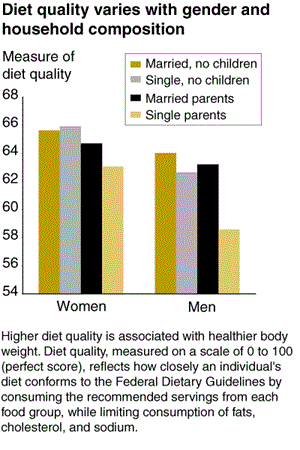Americans at Unequal Risk for Obesity

The well-publicized rising incidence of obesity in America is occurring among all population groups. Not everyone, however, is equally at risk of becoming overweight or obese, or at risk for the same reasons. Researchers at ERS have found that individuals who have not gone to college, women with lower incomes, single mothers, and men in rural areas are significantly more likely to be overweight or obese.
Variation in body weight is partially determined by our genes, but is also related to what we eat and how active we are. Individuals who exercise more frequently, watch less television, drink fewer sugary beverages, and eat a healthful diet are more likely to have a healthy body weight. Differences in attitudes about diet and health also correlate with weight differences. Compared with healthy-weight women, overweight and obese women are less likely to believe they have control over their weight. And overweight and obese men are less likely to assess their weight status accurately than healthy-weight men: nearly 60 percent of overweight and obese men consider themselves to be a healthy weight.
ERS researchers found that several socioeconomic factors, such as the level of education, marital status, and the presence of children in the household, correlate with the food choices, activity levels, and health-related attitudes that affect body weight. For example, people with a college education eat a more healthful diet, watch less TV, drink fewer soft drinks, and skip breakfast less often. Women with a college education have a greater feeling of control over their own weight and exercise more frequently. Married parents have a more healthful diet, skip breakfast less often, and drink fewer sugary beverages than single parents. Women who are married with children watch less television than women without children or single mothers. And, men with no children exercise more frequently than men with children.
Insights from this study can suggest ways to tailor health education for specific individuals to promote changes in certain behaviors and attitudes. For example, encouraging busy single parents to incorporate frequent, but not necessarily lengthy, sessions of physical activity into their daily routine may be more effective than prescribing 30 minutes of continuous activity each day. Other groups of Americans could benefit from more tailored nutrition and exercise messages as well.
The Role of Economics in Eating Choices and Weight Outcomes, by Lisa Mancino, Biing-Hwan Lin, and Nicole Ballenger, USDA, Economic Research Service, October 2004


